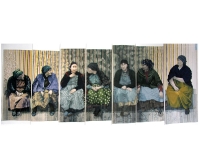ANDREA MILDE
1963
Germany, Spain
LAS SIETE MARÍAS / SEVEN MARIES. 1996–2001.
Jute, wool, cotton, silk, linen, metalic thread, gobelin haute lisse. 7 x (160 x 65 cm).
4 years
When you weave on a tapestry for more than four years, many things might happen, not only in the world which rushes past with increasing speed and global complexity, nor only in the close environment, where birth and death as ever go hand in hand with one another, but especially within yourself, because throughout the many hours of almost meditative work you take stock of yourself and contemplate your own past and future.
Within four years, you change, because life leaves its traces, on the inside as well as the outside. Within four years, new ideas come and go, priorities shift and sometimes the content of the piece you are currently working on changes, things that you experience and learn about during the working process contribute to the overall work.
3 generations
My Siete Marias had started taking shape inside my head long before 1997. I myself grew conscious about this much later, when I completed them one after the other, when my children grew older and my mother got old, when I became increasingly aware of the extent to which the story of her life, even my grandmother’s personal history, were interwoven with my own and the one of my children.
Spatial distance and a sort of temporal dislocation in my adopted country Spain, which confronted me with a society that developed very differently from the society I had grown up in, helped me realise this.
Like many others my grandmother and my mother, still a little girl at that time, had to flee their rural home in today’s Poland during the Second World War and start a new life in Germany. In the factory and the small city apartment they in their hearts always remained farmer women, down-to-earth, with rough hands, crocked backs, with a seemingly indefatigable will to survive but also with the tendency to accept what is commonly referred to as “destiny”, that I hardly understood.
Their lives were strongly influenced by an attachment to nature, of which the cyclic growth and decay re-echoed in their own lives; by the effort to preserve traditional customs; the effort to communicate wisdom. They were governed by their understanding of interpersonal relationships which, carefully woven and compacted, developed into a securing yet sometimes restricting social network. To me these women became a metaphor for an attitude to life which comprised a different interrelationship between “Man” and “Time”, of a concept of time which embraced slowness not as disturbing but as sometimes necessary.
And when I chose this group of women as my weaving’s leading motif it felt as though I had met them here in Spain, as though I might only have really found them, gotten to understand their true personality. Many of the conflicts we dealt with within the family circle, the narrow-mindedness, the lack of understanding, walls of unvoiced fears, doubts and desires were suddenly laid open on a societal level, which initially was strange, but due to a lack of emotional attachment enabled me to review and re-contextualise my life experiences. My conception of womanhood, which I owe to a change of thinking in society rather than to the personal convictions of women in my family, is characterized by autonomy and independence, a northern European notion as one might say. Having internalized this conception throughout, I then encountered a southern European structure of society that was marked not only because of the influence of the Catholic church, where a woman’s figure is adored as Mother of God, and the women of flesh and blood not get a word in edgeways, but in the case of Spain, also due to forty years of dictatorship. When I came to Spain the first changes showed timidly, but the majority of young women, “my” generation in fact, who would have had to drive these changes forward with strength and conviction, were maybe prepared argumentatively, but the fewest were emotionally ready. They are the daughters of mothers, whose role had over decades been limited to house and home. There had not been a time comparable to the post-war years and reconstruction in Germany, painful but full of change. Quite the opposite, everything stagnated under the repression by prosecution and church. The new generation of women was lacking role models. The champions of women’s rights were too far away both time-wise and spatially, to assist in the redefinition of the woman’s roll in modern society. Tomorrow’s mothers hovered between the need for a clearly defined though old-fashioned place in society, the discontent with the boundaries that restricted their self-actualisation and their guilty conscience when they challenged traditional roles and searched for new perspectives. It took me several years to understand this, years filled with despair because I felt myself so different to these women, and their passivity made me nervous and sometimes even angry.
7 stories about women
On the 17th December 1997 I had just finished weaving the first of my ‘Siete Marías’ and was busy editing the outline of the second one. On this 17th December the sixty-year old Ana Orantes was burned alive by her husband after having talked on TV about his acts of abuse she endured during her forty years of marriage. On this 17th December I sat in my studio all night long with the outline in front of me, listening to women who were upset, indignantly and resignedly reporting on similar cases of domestic abuse on the radio. The issue automatically became a part of the outline. A cartoon-like story developed along the bottom edge of the tapestry, whose sequence of images summarizes the numerous fates and suggests a very different ending.
All of a sudden the rolling landscape of weary shoulders, chapped hands and calloused knees longer concealed the snapshot of a chin-wag in the afternoon sun, full of superficial tattle and ambiguous comments. Between the threads of the tale appeared lost illusions, unfulfilled dreams, the desire to be loved and deprivation of love.
After the four years of weaving on the loom, the departure of my mother, during the upbringing of my two children in a world that constantly changes I have no doubt that there are things which the collective memory must never forget. I also try to raise more sympathy, more patience, because there are things that take their time.
Now I feel much closer to my grandmother and mother. Just as though the thread of my life had formed a loop which joins our individual fates at a common point, even if at different levels.














One Response to Milde, Andrea
Marion Michell
Replied on: %A %B %e%q, %Y, %I:%M %p
Your Seven Maries are beautiful. I just glimpsed them in a short video about the biennial and there they were, gently moving and looking very much alive. Looking at your pix posted here they seem to be three-dimensional, metaphorically as well as materially. Under the layers of clothing we sense their bodies: marked by history, by their own stories. They are the kind of women far away from beauty products that promise eternally young looking faces and bodies. I’m thinking of a documentary I saw years ago, about old women in Russia, babuschkas, who live on their own, with tiny plots of land, where they grow the bare necessities for survival with a tiny pension. Hard work till they die. There are women like that everywhere, not paid much attention to. The strength they have, living bare lives. Living.
Touching, powerful work. Wished I could see it up close.